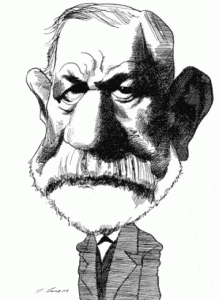
Thanks to Sigmund Freud’s 1917 essay, “Mourning and Melancholy,” we have a puzzle about unhappiness, not just the unpleasant depressive feelings human subjects universally experience with both of these sad situations. Let’s take a look at the clues as if we were in a detective novel.
We spray the crime scene of sadness with an aerosol that makes invisible marks, smudges, and fingerprints visible. Mourning and melancholy are both about cathexis, one of the fancy words James Stachey, Freud’s translator, likes to use to make ordinary German words (Besetzung in this case) sound professional and fancy. It’s “investment,” primarily of feelings, but they leak over into symbolic things. Falling in love, for example, can lead to marriage.
Freud’s over-arching observation is that the withdrawal of cathexis creates a void. Human beings do not like to abandon a position once they fill it with libido. This involves a fixed measure of investment. We don’t know the units, but there is always a rational component (we explain to ourselves that we like someone because we enjoy doing the same things) and an irrational component (crazy in love, more often than not, with the wrong person). We might write this mathematically, as a+bi, the famous algebraic expression for complex numbers, involving i, the square root of –1. It can be plus or minus, doesn’t matter.
Units of measure presuppose a circuit for energy conservation. We have a fixed amount of libido. We know this because when we invest and withdraw it, there is always the issue of how much is enough or too much.. When we feel cheated by loss, it is because we have done the counting and come up short. When we give someone flowers for Valentine’s Day, it’s because we feel we have to make up for a shortage. These all imply units of measure, although we can’t represent them as easily as feet or meters or hours. They combine a natural component, a, with an irrational component, bi. With mourning and melancholy, there is always the issue of equalities and, hence, circuits to preserve those equalities.
It’s no problem to have a circuit with an irrational unit of measure, but it means that there will always be a remainder, a residual, left over after we account for everything we know about a situation, and that, too, requires conservation and its own circuit. Lacanians call this bi element jouissance which can be positive (enjoyment) or negative (suffering). Sometimes we confuse one for the other, as anyone who has fallen in love knows all too well. Summary: the need to conserve energy > an insulated circuit > units of measure > a way of expressing this as a complex number, to account for the irrational element of libido.
This puzzler is described in a flier. Contestant submissions will be posted here.
- Andrew Payne: “Architecture and Melancholy: A Few Inconclusive Thoughts in the Aftermath of our Discussion”
If, following psychoanalytic doctrine, melancholia would consist in the rerouting of libido from object to ego, then our question may be put as follows: to what extent might that reversal of libidinal fortunes play a role in the creation and reception of (some? all?) works of architecture? This formulation demands a caveat, however, for the transference of libido from object to ego, far from being peculiar to melancholia, is according to Freud an everyday feature of psychical life, so it remains for us to clarify what distinguishes this redirection of libido in the case of melancholia. Indeed such a clarification is just what is promised in the title to Freud’s essay. With that in mind, permit me to say a word about how Freud distinguishes melancholia from normal mourning in that work. - Don Kunze: (Not about the Mystery Story either): “Melancholy and Jouissance” This is a story of oldest and first. Melancholy is a part of the oldest medical system in the world (humoristic); although the version we know comes from Empedocles, there was undoubtedly an older, shamanistic version that was based on seasonal change, not logical opposition. This would position melancholy between the death of the phlegmatic humor and the rebirth of the sanguine. This position is confirmed by melancholy’s key motif, the theme of the two deaths, the literal death and symbolic death, separated by a period of wandering, known to all cultures. This paper argues for a a broad expansion of melancholy, as a program for knowledge … the need to go beyond the formula of “justified true belief ” to add a small amount of black bile.